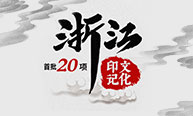Gejia village impresses with its artistic outlook
Creative endeavor breaks through to the heart of community
Several months ago, the Red Peony Academy of Chinese Painting and Calligraphy invited us for a trip to Gejia village in Ninghai county of Ningbo, Zhejiang province. We were told that we were going to visit a village, which is engaged in some kind of art project. Each opportunity to visit places not found in travel guides is, from our point of view, worth taking.
We decided to go. During, and soon after the trip we learned that this engagement was much deeper and better organized than we thought.
The story began when we visited Gejia village for the first time. At the beginning we had mixed impressions. On the one hand Gejia village appeared to be just one more Chinese village located not far away from our home in Ningbo. On the other hand, however, we saw some pictures which awoke our curiosity. To be honest, with time this curiosity has been getting bigger and bigger.
We can remember how astonished we were by the vivid colors decorating the wall of the building located at the beginning of the so-called "Professor's Path". The deeper we went into the village, the more the efforts to beautify it attracted our attention. Bamboo flower pots, facade decorations, nicely arranged flower beds, art installations made of bamboo, empty bottles, old tires, etc.
Pretty quickly we realized that the beauty of those bigger and smaller objects can be experienced so deeply because the streets, yards and public places in the village are very clean.
After a while we understood that it was possible because at least some of the objects and materials, in many other villages would be considered to be rubbish, but in Gejia village they have been used to make artistic objects.
This kind of "green thinking" in the rural area moved us in a very pleasant way. In the village surrounded by bamboo forest and filled with the fragrance of osmanthus trees, quite a few artifacts, including tools, art objects, and even culinary specialties like osmanthus flower tea, are made of these "domesticated" and local materials. And, what's more, everything has been made by the members of local community.
Our curiosity achieved the level at which some questions had to be asked. While talking to the villagers we learned that the whole idea of using art to alleviate living conditions in the village appeared around 18 months earlier.
It was when professor Cong Zhiqiang from Renmin University of China in Beijing was invited to a discussion about the possibilities of using art to change the image of the village and improve the quality of people's lives.
At the beginning it was not so easy to introduce the idea of using art to make local people's life better because, as they thought and said, they had no idea what art was. They felt not so into this project because they said they didn't understand art. Art in their concept was something remote, difficult, too abstract, useless, without any practical usage.
Despite this initial doubt and objections, thanks to the very empathetic and understanding approach of professor Cong, even the most unconvinced locals eventually decided to join and support the project.
After they realized that even the trivial things, the most casual objects like parts of clothes, everyday utilities could be turned into art objects, art itself ceased to be abstract, alien and impossible to understand. And, what is probably even more important, art, like water or air, became an integral part of their lives.
As outsiders, we noticed the artistic movement in Gejia village may be compared to similar phenomena appearing all over the world. In particular, using local resources and know-how, social engagement and adopting recycled materials belongs to a modern artistic trend called "socially engaged art" or "participatory art".
The most important factor of this kind of art is its conversational character. The act of doing art is quite often much more meaningful than physical objects. Thanks to it nobody should feel excluded.
We had the opportunity to talk to some representatives of Gejia village, and we found out that beauty and art, in some mysterious way, inspired people to be even more creative, innovative, and sensitive to the environment and nature.
At the same time, what seems to be even more important, the art and sensitivity to beauty opened people's eyes and hearts to their neighbors. Art became the engine thanks to which Gejia village dwellers started to cooperate and spend more time together. The village, just like home, became a center of people's efforts, the place everybody wanted to take care of.
Gaston Bachelard, a French philosopher, said: "Our home is our corner of the world…it is our first universe, a real cosmos in every sense of the word."
The relation between people and the place of their birth is usually very intimate. In a village like Gejia village, this old truth is very visible. We can see the personal character of this relationship in every corner of the village, when we look at beautiful sculptures made of sea shells, flower pots made of bamboo, cactus plants decorating a local pub, colorful wall and stone paintings.
We have to remember that behind every piece of art stands a real person. The person transforming abstract ideas of love, friendship, loyalty into tangible objects we can see, and touch, and admire. Each family has its unique input to the project either through craft or decorating. Each house becomes exceptional.
We believe that it was possible thanks to the very empathetic approach that professor Cong applied while introducing art to Gejia village dwellers. He decided not to lecture them, but to work with them, showing the way of participatory and dialogic art. The efficiency of this approach has been proved by the fact that 13 villagers became project ambassadors visiting distant places to share their experience, and if necessary give some advice to people who would like to repeat their success.
All of us would like to have a happy, safe and meaningful life. In Gejia village, we can see people who-with a little help from their friends-try to make this dream come true. Edward Relph, a Canadian geographer said: "… to be human is to have and know your place."
We believe that the identity of the place is only partly located in material objects, streets, buildings and trees. To know your place you also need to know the spirit of the place, genius loci, the atmosphere. You need to know and understand the local customs, people's habits, taboos. All these elements together create a very meaningful net of relationship. To know it, you need to become a part of it. When you become part of it you will understand it. The very moment you understand it you may start building the future of the place.
The authors are professors with Ningbo Tech University.

Magdalena Gimbut and Artur Piotr Rega talk with local residents in Gejia village. The residents' lives have been improved as the village makes progress in development by taking advantage of art. CHINA DAILY

Gejia village in Ninghai county of Ningbo is decorated with artistic elements. Visitors take photos at Gejia village, which has improved its image by taking advantage of art. XIAO DA/CHINA DAILY

 Print
Print Mail
Mail
 20 Cultural Symbols
20 Cultural Symbols Why Zhejiang
Why Zhejiang Experiencing high-tech products at WIC
Experiencing high-tech products at WIC Zhejiang Release
Zhejiang Release Zhejiang News
Zhejiang News